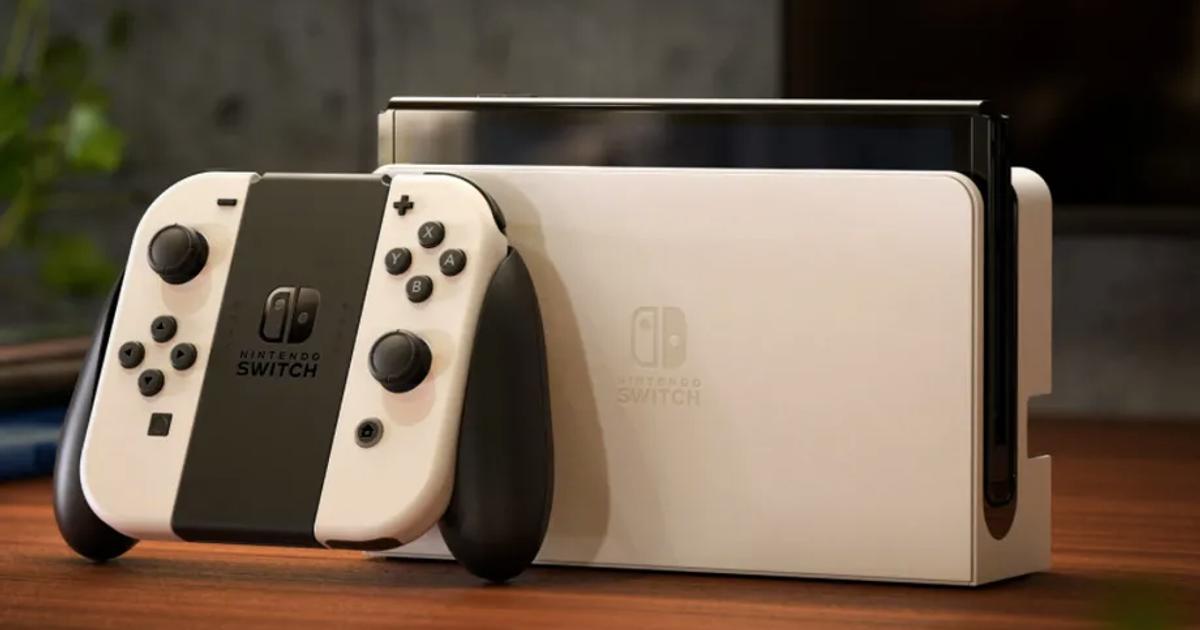After two years of endless rumours, Nintendo finally lifted the lid on their newest Switch revision yesterday. No fanfare, no big E3 conference or pre-warnings, just a casual news drop on a random Tuesday, telling us the Nintendo Switch OLED Model will launch on October 8, 2021. Now that we've seen it though, what's unclear is just who this revision is actually targeting.
To begin, let's look at what's changed. White colour scheme aside, Nintendo confirmed this new system features a "vibrant" 7-inch OLED screen, a wide adjustable stand, a dock with a wired LAN port, 64 GB of internal storage, and enhanced audio. If you were hoping for performance upgrades, well, we've got bad news, it doesn't have any. There's no new CPU or more RAM and no 4K output, the internal specs are largely unchanged.
Read More: Nintendo Switch Pro: OLED Model and Everything We Know
Nintendo Switch OLED Model Offers Modest Improvements, But Who's The Target Audience?
A few details match rumours we'd previously seen, but for many, that proved disappointing. OLED Model isn't the mid-generation upgrade some were hoping for, more like a Switch XL than a DSi or New 3DS. While rumours intensified before E3 2021, I've always suggested taking them with a pinch of salt to keep expectations in check. Nintendo never actually promised such a hardware upgrade, after all.
I don't blame people for wanting that upgrade, though. The Switch already felt underpowered compared to the PS4 and Xbox One, and that gap's widened with the PS5 and Xbox Series X|S releasing last year. You can't deny that outside more exceptional porting efforts like DOOM Eternal, the Switch is struggling to run newer games well. It's why Cloud Editions have popped up for Guardians of the Galaxy, Control, Hitman 3, A Plague Tale: Innocence and the trend's likely to continue.
That's without considering the global semiconductor chip shortage too, largely been caused by the surge in demand for home entertainment thanks to Covid-19. Anyone who's tried obtaining a PS5, Xbox Series X|S or new Nvidia graphics card can tell you how much of a struggle it's been. Demand is high but supply is low, so creating a new model with a fresh chipset would likely face similar stock issues. Improving existing models is an understandable alternative.
However, just focusing on the competition misses the point, and the Switch's portability targets a different market to PS5 and Xbox Series X|S. Sure, adding extra horsepower to the Switch could bring in wider sales than this OLED Model, but having reached 86.7 million sales in just four years, Nintendo don't need to, either. Higher specs for docked play would be nice, of course it would, but that's not what drew people in, and Nintendo know it. Chip shortage aside, the Switch is already selling brilliantly, Nintendo simply might not see a business need for a "Switch Pro" right now.
Throughout Nintendo's history, they've always sought new ways to play, something that goes back to Gunpei Yokoi’s 'lateral thinking' philosophy. Prioritising gameplay over new technology, that's admittedly led to a few misses previously - sticking with cartridges on N64, Wii U, Virtual Boy - but when done correctly, they've been wildly successful. The DS and Wii didn't have the strongest specs compared to the PSP and Xbox 360/PS3 respectively, but they convincingly outsold both.
My point is, Nintendo don't have to chase the newest hardware to be successful. Where they've innovated, they've sold, and by offering a bridge between handheld and home consoles, the Switch built upon the Wii U's failures to incredible success. But, these factors raises another question. Just who exactly is the Switch OLED Model for?
After all, this is a modest upgrade from existing models, one that mainly benefits handheld play and at £310, costs £30 more than your standard Switch. For anyone predominantly using docked mode, there aren't any discernible benefits. Targeting handheld players would be one thing if Nintendo hadn't already released the Switch Lite, the handheld-only option that retails for £200. OLED Model's offering a more premium handheld experience while retaining docked functionality.
While that could favour those who want a better "tablet" console from the Switch, that's a very niche audience. In my mind, a more likely scenario is that this OLED Model will eventually replace the standard Switch console, and that theory's also backed up by Bloomberg reporter Takashi Mochizuki, who correctly confirmed a September/October release before this reveal. Such a strategy wouldn't be too surprising, considering Nintendo ended New Nintendo 3DS production in 2017 to favour the XL model, before officially discontinuing the 3DS line entirely last year.
Ultimately, the Nintendo Switch OLED Model isn't the Switch Pro many had hoped for, but from what Nintendo's shown us, it was never meant to be. Taking an evolutionary over revolutionary approach, there's some good quality-of-life additions included but most existing owners won't need to upgrade. New hardware will inevitably appear - be it a full successor or Pro upgrade - but that time hasn't come yet.






